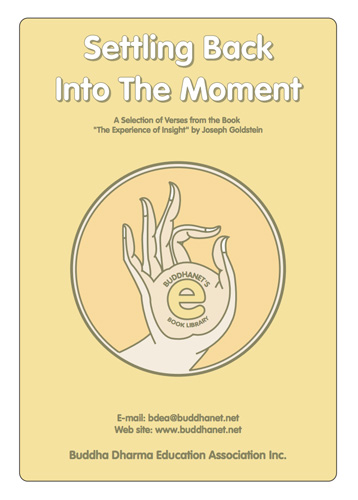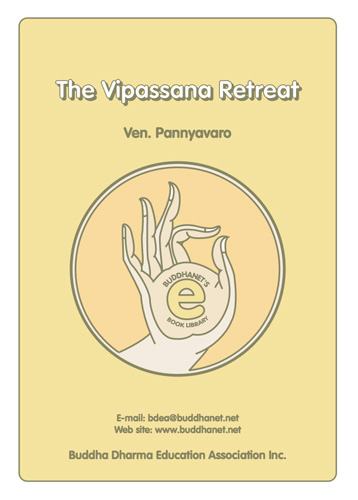 Most viewed - Buddhist Meditation Most viewed - Buddhist Meditation |

settleback.pdfSettling Back Into The Moment3837 viewsA selection of verses from the book 'Experience of Insight' , by Joseph Goldstein. This book belongs to a different genre, not a book in the sense of having a beginning and an end. It is a compilation of excerpts that stand alone in meaning whichever way your finger may flip open the page. Readers are strongly encouraged to read Joseph Goldstein's Experience of Insight - a simple and direct guide to Buddhist Meditation (Published by Shambala Publications, Inc.) from whose book this compilation is attributed.
|
|

v_retreat6.pdfThe Vipassana Retreat3759 viewsVen. Pannyavaro
Vipassana meditation requires long-term commitment. While it can be done to some extent in everyday life, realistically for the practice to deepen it needs to be done intensively in a supportive retreat situation. Vipassana meditation is developmental, so to realise its ultimate benefit it has to be sustained with appropriate intensity under supportive conditions. Ven. Pannyavaro, a practitioner of over 30 years, guides you through the vipassana experience in a retreat situation, in a systematic and practical way.
|
|

monkeym.pdfTaming the Monkey Mind3677 viewsCheng Wei-an. Tr. by Dharma Master Suddhisukha
Taming the Monkey Mind is a guide to Pure Land practice. It deals specifically with the main practice of the Pure Land School - Buddha Recitation - and covers both the noumenal and phenomenal aspects of that practice. The treatise is accompanied by the detailed commentary of an Elder Master of the Zen and Pure Land lineages. Readers not familiar with Pure Land theory may wish to begin with Dr. J.C. Cleary's introduction.
|
|

Mindfulness_Breathing.pdfMindfulness of Breathing3666 viewsThis is a useful anthology of important and pragmatic source material from the Pali Canon and Commentaries on the technique of Anapana, or breath-awareness meditation. It includes the Discourse on Respiration-Mindfulness from the Majjhima Nikaya, commentary from the Vishuddhimagga (Path of Purification), and analyses of other passages and Suttas.
|
|

Things_as_They_Are.pdfThings As They Are3568 viewsIn order to be principled and methodical in your training, keep your awareness constantly with the body. Keep mindfulness focused there and use wisdom to investigate within the sphere of the body. The more you investigate the body until you understand it clearly, the more sharply you will understand the affairs of feelings, memory, thought-formations, and consciousness, because all these things are whetstones for sharpening wisdom step by step. It's the same as when we bail water out of a fish pond: the more water we bail out, the more clearly we'll see the fish. Or as when clearing a forest: the more vegetation we cut away, the more space we'll see. When you use wisdom to contemplate in this way, the currents of the heart will become plain...
|
|

Forest_Dhamma.pdfForest Dhamma: A Selection of Talks on Buddhist Practice3450 viewsTraining the heart to attain happiness is the way that all the Buddhas proclaimed to be the right and true way. When our hearts never have time to rest and attain calm, they are not fundamentally different from those of animals. But when our hearts rest, relax and receive training, we will be able to see the harmful affects of thinking and imagining, and turbulence they cause in the heart. Then we will come to see the value of a calm heart. Once we have attained a state of mental calm, we will have reached the first stage of Dhamma, which will lead us steadily onwards. In other words, we will have a firmly established faith in the principles of Dhamma...
|
|

TowardsAnInnerPeace-VF11p.pdfTowards an Inner Peace3446 viewsIn Towards an Inner Peace, Venerable Dhammajiva instructs yogis to progress by developing continuous mindfulness and deep concentration. He takes yogis through a journey, which progressively leads to the development of vipassana insights. His step by step instructions provide an invaluable theroretical basis to confront and embrace the challenges along the path to attain a state of path and fruition consciousness.
|
|

hello_with_love.pdfHello - with Love & Other Meditations3427 viewsMaster Visuddhacara
The three most important things in life are love, kindness and wisdom. If we have made these three values the priorities of our life, then our life will have been well-lived. When we die we can only have happiness when we look back and not regrets. Wealth, fame, power, status, worldly success and pleasures - these are insignificant compared to love, kindness and wisdom. Cultivate the latter. If we spend our life cultivating this trio, our birth and life will have been worthwhile; it will not have been in vain. In this booklet, Ven. Visuddhacara shares his understanding of this practice of mindfulness and loving-kindness with a view to encourage all of us to walk the path.
|
|

02Orientation_to_the_Practice.pdfOrientation to the Practice3281 viewsWhether this is a first time experience of Vipassana meditation or you are a meditator who has experience in this mode of practice, every meditator at the beginning of a retreat will need to make some adjustment to the retreat situation - at least in having to settle down and get into the rhythm of the practice. First, let us look how one relates to a retreat situation and the way to adjust to the retreat environment, before the basic instructions are given.
|
|

seeding.pdfSeeding the Heart3227 viewsGregory Kramer
Loving-kindness Meditation with Children. The practice of loving-kindness, or metta, can be done in one of two ways: either in intensive prolonged meditation to develop deep states of concentration, or in daily life at any time one meets with people and animals or thinks about them. To learn about the radiating of metta to all beings with children, we have to tap into the store of knowledge accumulated by lay people and parents. It must be knowledge which has grown out of years of living and loving with children and young adults. Gregory Kramer, father of three boys, shows us here with what subtle but precise adjustments in the standard practice of loving-kindness he was able to anchor it in the lives of his children.
|
|
|
|
